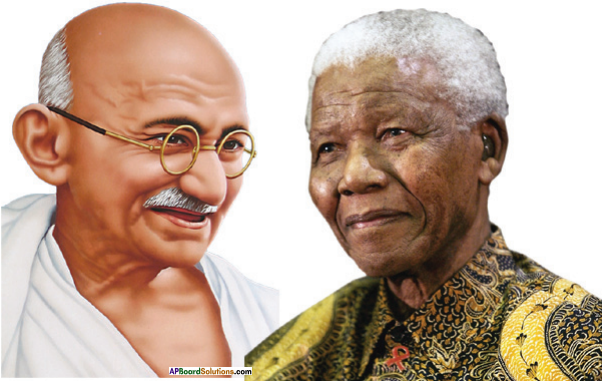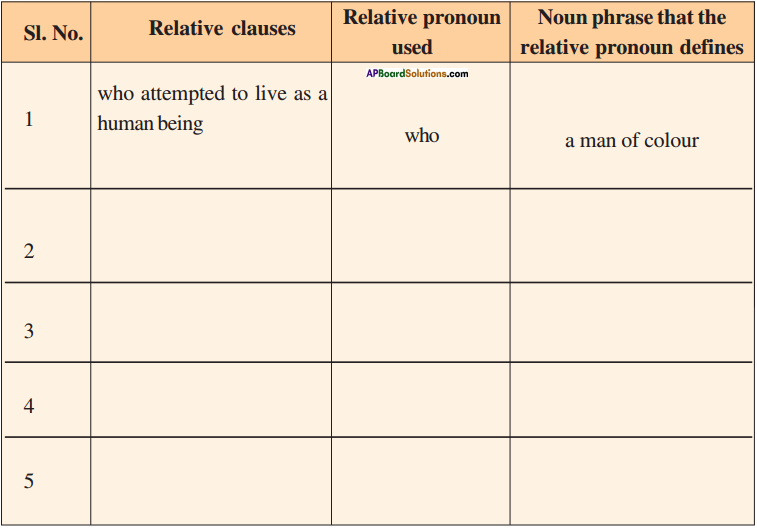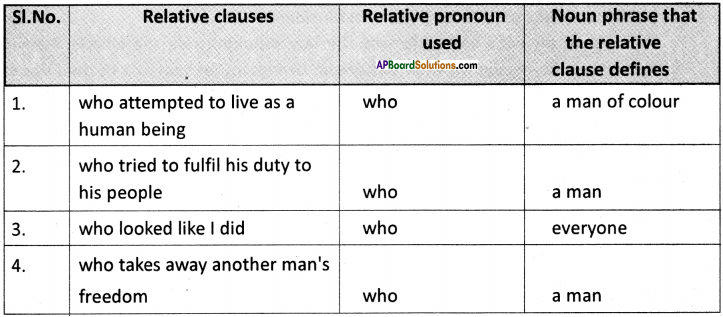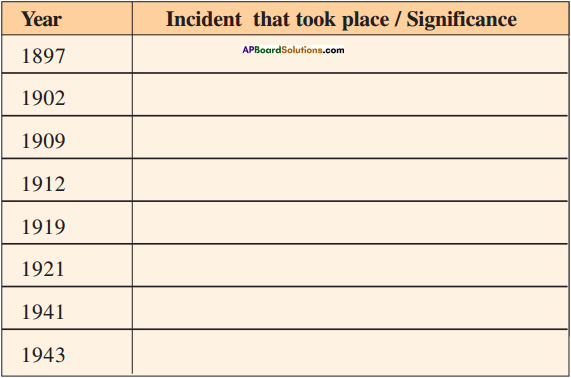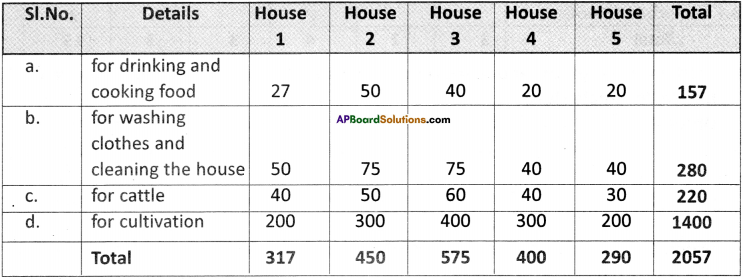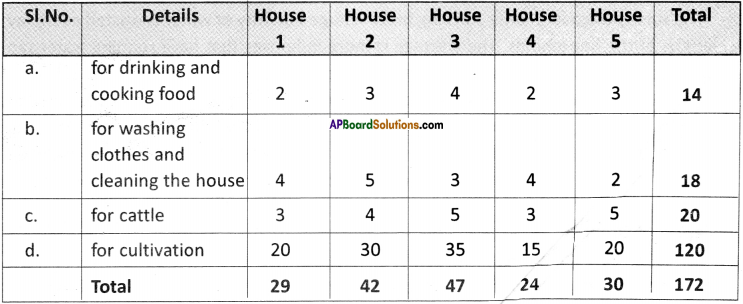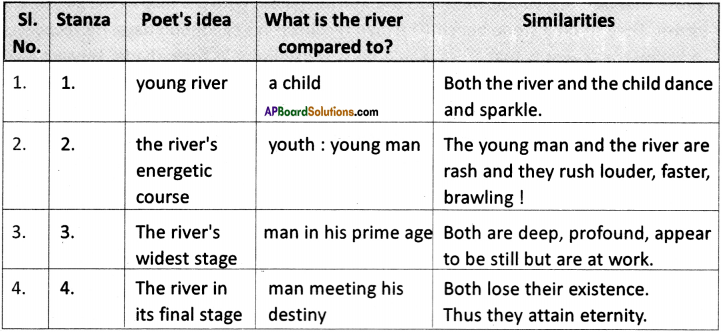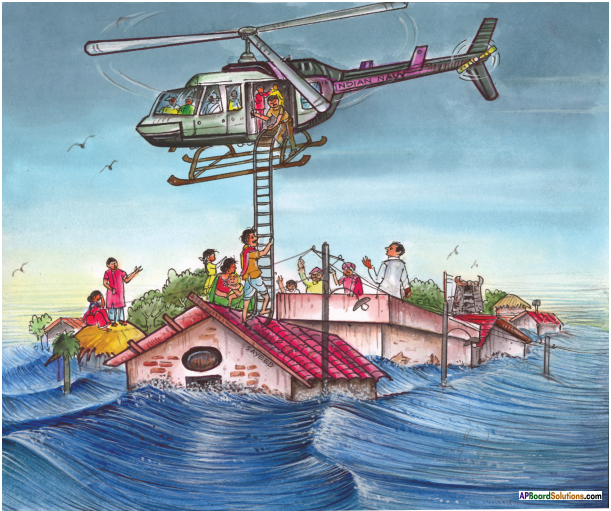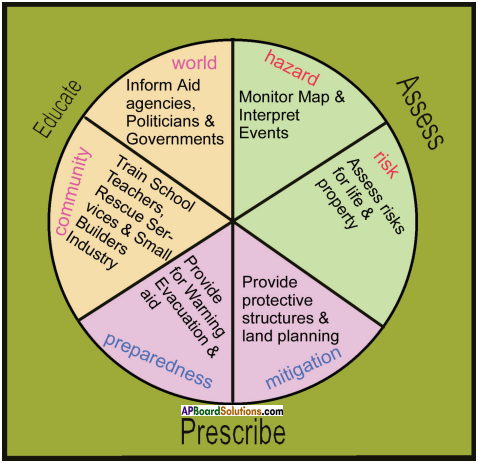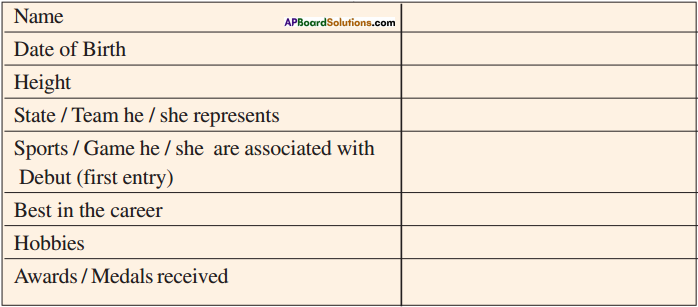AP State Board Syllabus AP SSC 10th Class Hindi Textbook Solutions उपवाचक Chapter 2 दो कलाकार Textbook Questions and Answers.
AP State Syllabus SSC 10th Class Hindi Solutions उपवाचक Chapter 2 दो कलाकार
10th Class Hindi उपवाचक Chapter 2 दो कलाकार Textbook Questions and Answers
प्रश्न 1.
अरुणा व चित्रा दोनों के स्वभाव के बारे में अपने विचार बताइए।
उत्तर:
अरुणा और चित्रा दोनों अच्छी सहेलियाँ हैं। वे दोनों एक हास्टल में रहती हैं। अरुणा समाज सेविका है। चित्रा चित्रकारिणी है। अतः अरुणा को समाज सेवा में अधिक रुचि है। चित्रा को चित्र कला में रुचि है। रोग पीड़ित बच्चों की सेवा करना, उन्हें अस्पताल ले जाना वहाँ डॉक्टरों से चिकित्सा कराना, दवा दिलाना, आस -पास के गरीब बच्चों को शिक्षा – दीक्षा देना आदि में अरुणा अपना समय बिताती है और आनंद लेती रहती है। चित्रा अपनी चित्र कला द्वारा समाज को बदलना चाहती है। अरुणा को तो चित्रा की चित्र कला निरर्थक तथा बेमतलब लगती है। अरुणा चित्रा से निर्जीव चित्र बनाने के बजाय दुखी तथा असहाय लोगों की सेवा करने को कहती । चित्रा धनी बाप की बेटी थी। दोनों में इतना अंतर होने पर भी वे दोनों सच्ची दोस्ती को निभाती हैं।
प्रश्न 2.
चित्रा ने विदेश जाकर क्या किया? आपके विचार में उसका विदेश जाना सही था। क्यों ?”
उत्तर:
चित्रा ने विदेश जाकर तन – मन से अपना काम चित्र कला सीखने तथा चित्र खींचने में जुटा दिया। चित्रकला के प्रति उसकी लगन ने उसकी कला को निखार दिया। विदेशों में उसके चित्रों की धूम मच गयी। भिखारिन और दो अनाथ बच्चों के चित्र की प्रशंसा में तो अखबार के कालम के कालम भर गये। अनेक प्रतियोगिताओं में उसका अनाथ शीर्षक वाला चित्र प्रथम पुरस्कार पा चुका था।
मेरे विचार में तो चित्रा का विदेश जाना सही था। क्योंकि हर एक को अपनी – अपनी इच्छाएँ होती हैं। चित्रा चित्रकला में पसंद रखती है। वह अच्छी चित्र कारिणी बनना चाहती है। वह अपनी आशाओं को सफल बनाना चाहती है।
![]()
प्रश्न 3.
अरुणा की ममता पर अपने विचार बताइए।
उत्तर:
ममत्व, मानवता तथा दूसरों की सेवा में ही हम भगवान का दर्शन कर सकते हैं। ठीक विचार है अरुणा की। सचमुच अरुणा ममता की मूर्ति है। अरुणा में दया, सेवा, त्याग और ममत्व आदि भावनाएँ भरपूर हैं। वह आसपास के गरीब बीमार बच्चों को अस्तताल ले जाना, वहाँ उनकी चिकित्सा करवाना, निर्धनी तथा गरीब बच्चों को पढ़ाना। असहाय लोगों की सेवा करना आदि उसकी ममता तथा सेवा भाव का परिचायक है। इतनी ही नहीं कि एक भिखारिन मर पड़ी तो उस मरी भिखारिन के पास रो रहे दो बच्चों को वह गोद लेती है और अपने बच्चों की तरह उनका लालन – पालन करती है। उनकी माँ बनती है। ममत्व बाँटती है। इस प्रकार अरुणा एक ममत्ववाली, दयामयी, स्नेहशीली और उत्तम सेविका के रूप में हमारे सामने उपस्थित होती है।
दो कलाकार Summary in English
Aruna and Chitra were friends. They were studying college education staying at a women’s hostel. Of them, Chitra was a rich man’s only daughter. She was interested in painting. She was always engaged herself in painting pictures with different concepts. Her aim was to go abroad after completion of the course she was doing then.
Aruna was a kind hearted person. Hers was a helping nature. She would educate the poor children. She was also interested in social service.
Whenever Chitra showed her paintings Aruna would advise her to give life for some poor people instead of painting pictures twenty four hours.
Once it was raining for three days incessantly. Every day newspapers were publishing news about floods. The victims were in a pathetic condition.
Aruna was moved by this situation. She decided to help them and was engaged herself in collecting funds for the sake of flood victims. Even the time of examinations was approaching, she took part in that programme. Having taken permission from the Principal she went along with the volunteers’ team. After fifteen days she returned. Her health was damaged. At that time, Chitra had gone to her instructor. Once while going to bed, Aruna happened to see the paintings painted by Chitra. those paintings related to the floods seemed very natural which reflected the plight caused by the floods. She was upset about it.
![]()
After returning, Chitra felt very happy on seeing Aruna. She told Aruna that she was leaving for abroad after a week. She looked very elated.
They both were staying at the same place for six years. There was a close friendship :between them. So Aruna was disappointed to hear that her bosom friend going abroad.
That day arrived. Chitra was about to travel by the 5 p.m. train. Aruna kept Chitra’s luggage ready. Chitra met all her friends. She went to her instructor to take his blessings. There was no much time for her departure. So Aruna went out to find out why she was late. Later Chitra come there. Asked by two of her friends, she said that she had seen a feeble beggar woman in front of Garg store. There she lay dead. Her two children were wailing over her mother’s death. She was moved to see that distressing scene and had drawn a rough sketch. She came late because of that very reason.
Chitra went abroad and she completely immersed herself in painting work. Because of her dedication and perseverance, she became an expert in her field. Her paintings became popular in foreign countries. The painting of beggar woman and her two destitute children was published in every magazine there. That painting got good applause from the people. It received many first prizes in various competitions. She reached peaks in her career and forgot all the past. For the first year, she corresponded with Aruna through letters. Gradually communication between them came to a halt.
After three years, she returned to India. She was received with a grand welcome. Many articles about her art and her life were published in magazines. Her father felt proud of her achievements. An exhibition of her paintings was held in Delhi.
Aruna attended that programme with two children a ten-year-old male child and an eight year old female child. Chitra was overjoyed to see Aruna and embraced her. She asked Aruna whose children they were. Aruna said that they were her children. Asked by the children, Chitra showed them all her paintings. She told Aruna that the painting of the beggar woman had brought her good fame.
![]()
When her husband came there, Aruna entrusted him with the responsibility of the children. She told him to take the children to the paintings exhibition and said that she and her friend Chitra would go home.
The children went along with their father unwillingly. Chitra stared at them till they had gone out of her sight. She again asked Aruna who those cute children were pointing to the two children in the painting of the beggar woman, Aruna said that they were the two children seen in the painting. Chitra become dumb-struck with amazement.
दो कलाकार Summary in Telugu
దుప్పటి కప్పుకుని నిద్రిస్తూ ఉన్న అరుణను తన స్నేహితురాలైన చిత్ర కుదుపులు కుదుపుతూ రూనీ నిద్ర లే అంటూ దుప్పటిలాగి నిద్రలేపింది. అరుణ కళ్ళు నలుపుకుంటూ కొంచెం విసుగ్గా “అరే ఏమైంది నీకు” అని అడిగింది చిత్ర అరుణ చేయిపట్టుకుని తను కొత్తగా వేసిన బొమ్మ దగ్గరకు లాక్కు వెళ్ళి అక్కడ నిలబడి చూడు నేను బొమ్మ గీయడం పూర్తి అయినది. అని చెప్పింది.
ఓ! అలాగా దీన్ని చూపించడం కోసం నా నిద్ర పాడుచేశావా ? ‘ – అని అడిగింది అరుణ. ‘అరే! ముందు ఈ బొమ్మను చూడు. మొదటి బహుమతి రాకపోతే పేరు మార్చుకుంటా” అని అన్నది చిత్ర.
అరుణ ఆ బొమ్మను నాల్గువైపులకు తిప్పుతూ “ఎటు నుండి చూడమంటావో చెప్పు. నీకు వేలకొలది సార్లు చెప్పాను. ఏ బొమ్మ వేస్తావో దాని క్రింద ఆపేరు వ్రాయమని, అందువల్ల అర్థం చేసుకోవడంలో తప్పు జరగదని. లేకపోతే నీవు వేసిన ఏనుగు బొమ్మ గుడ్లగూబలా అనిపించవచ్చు’ అని అన్నది. బొమ్మకు కళ్ళను ఆనిస్తూ అరుణ “ఏ విధంగానూ నేను ఈ బొమ్మ ఏ జీవిదో అర్థం చేసుకోలేకపోతున్నాను.” – అని అన్నది. అప్పుడు “చిత్ర అరే నీకు ఏ జీవి కన్పించడం లేదా? కొంచెం బాగా ఆలోచించి చూచి చెప్పు” అన్నది చిత్ర. “అరె ఇదేంటి? దీనిలో రోడ్డు, మనుష్యులు, ట్రామ్ లు, బస్సు, మోటర్ కారు, ఇల్లు అన్నీ ఒక దానిపై ఒకటి ఎక్కుతున్నట్లున్నాయి. అన్నిటిని కిచిడీలా వండి ఉంచినట్లున్నావ్ ఏంటి పెద్ద చక్రమేదో తయారుచేసినట్లున్నావ్?” అని అంటూ అరుణ ఆ బొమ్మను అక్కడ పెట్టింది.
అప్పుడు చిత్ర “కొంచెం ఆలోచించి చెప్పవే” ఈ బొమ్మ దేనికి ప్రతీకో?” అని అడిగింది అరుణను. “నీ మూర్యత్వానికి ప్రతీక”- అని ఠక్కున చెప్పింది అరుణ. “అరే ఈ బొమ్మ ఈనాటి ప్రపంచంలో పెద్ద క్యూజన్ గా ఉంటుంది.” అని చెప్పింది చిత్ర.
![]()
“నాకైతే నీ గుండె కన్ఫ్యూజన్ కి ప్రతీక అనిపిస్తోంది. అర్థం పర్థం లేకుండా జీవితాన్ని వ్యర్థం (పాడు) చేసుకుంటున్నావ్” అని అంటూ అరుణ అక్కడ నుండి ముఖం కడుక్కోవడానికి వెళ్ళిపోయింది. తను తిరిగి వచ్చే సరికి ముగ్గురు – నలుగురు పిల్లలు ఆవిడ గది దరవాజా వద్ద నిలబడి ఎదురు చూస్తూ ఉన్నారు. అరుణ వస్తూనే, “ఆ! వచ్చేశారా పిల్లలూ? పదండి, నేను కూడా వచ్చేశా” అని అన్నది.
“ఏమోయ్! ఈ కోతుల్ని పెంచుతున్నావా? ఒకరోజు నేను నీ పాఠశాల బొమ్మను కూడా గీయాలి. దాన్ని ప్రజలకు చూపించాలి. నాకు ఒక స్నేహితురాలు ఉన్నది. అది బస్తీలోని నిరుపేద పిల్లలకు, నౌకర్లు, చాకర్ల పిల్లలకు చదువు చెప్పి తనను ఒక గొప్ప పండితురాలుగా, సమాజ సేవకురాలుగా భావించుకుంటుంది. – అని నీ గురించి చెప్పాలి. అని అన్నది చిత్ర.
నాలుగు గంటలు అవ్వగానే కాలేజీకి చెందిన బాలికలంతా తిరిగివచ్చారు. కానీ అరుణ ఇంకా రాలేదు. చిత్ర టీ త్రాగడానికి అరుణ కోసం ఎదురుచూస్తోంది.
అరుణ రాగానే చిత్ర అరే ఎక్కడెక్కడ తిరుగుతావో ఎవరికీ తెలీదు అని అరిచింది. “అరె ఎందుకు బడబడ వాగుతావ్, నేనొచ్చేశా కదా! టీ తయారుచెయ్యి. ఇద్దరు కలిసే తాగుదాం” అని అన్నది అరుణ. అరుణకు వచ్చిన ఉత్తరాన్నిఁతన చేతిలో పెట్టింది చిత్ర.
అరుణ కవరు చించి ఉత్తరం చదవడం ప్రారంభించింది. అరుణ ఉత్తరం చదవడం అయిపోయాక చిత్ర ” ఈ రోజు నాన్నగారి దగ్గర నుండి ఉత్తరం వచ్చింది. నేను ఇక్కడి కోర్సు పూర్తి అవ్వగానే విదేశాలు వెళ్ళిపోతాను. నాకు తెలుసు మానాన్న గారు ఎప్పుడు కాదనరు” – అని అరుణతో చెప్పింది.
“అవునమ్మా! ధనవంతుని ఏకైక కుమార్తెవు. నీ కోరిక తీరకుండా ఉంటుందా? కానీ నేను నిజం చెబుతున్నా నాకు నీ కళలన్నీ నిరర్ధకం అనిపిస్తున్నాయి, ఎంత నిరర్థకం అంటే చెప్పలేను. దేని కోసం ఈ కళలు? ఇవి మనిషిని మనిషిలా ఉంచవు” – అని అరుణ ఆవేశంగా మాట్లాడింది.
“అయితే నీవు నన్ను మనిషిగా .గుర్తించడం లేదా?” – ఎందుకు? అని అడిగింది చిత్ర.
“నీకు ఈ ప్రపంచం అనే పదానికి అర్థం తెలీదు, ఇతరులను గురించి ఏమీ తెలియదు. 24 గంటలూ నీ రంగుల్లో కుంచెల్లో మునిగి తేలతావు. ప్రపంచంలో ఏ గొప్ప సంఘటన జరిగినా దానిలో నీ బొమ్మకు ఏమీ ఐడియా రాకపోతే ఆ సంఘటన ఎలాంటి గొప్పతనాన్ని పొందదు. ప్రతి నిమిషం, ప్రతి వస్తువు, ప్రతి చోట నీవు నీ బొమ్మల కోసం మోడల్స్ చూస్తుంటావు. కాగితాలపై జీవం లేని ఈ బొమ్మలను చిత్రించే బదులు ఇద్దరు – నలుగురికి జీవితాన్ని ఎందుకు ప్రసాదించకూడదు? నీ వద్ద ఆ సామర్థ్యం ఉంది. సాధనాలు ఉన్నాయి”- అని అన్నది అరుణ.
![]()
“చెలీ! ఆ పని నేను నీకే వదిలివేశా. నేను వెళ్ళిపోతే నీవు ప్రపంచ కళ్యాణం కోసం జెండా పట్టుకుని తిరుగు”. అంటూ చిత్ర నవ్వింది.
మూడు రోజులనుండి జోరువాన కురుస్తోంది. ప్రతిరోజూ వార్తాపత్రికల్లో వరదలకు సంబంధించిన వార్తలు వస్తున్నాయి. వరద పీడితుల పరిస్థితి విషమించసాగింది. వర్షం ఆగిపోయి ఎండ’ రావడం అనేది జరగలేదు. అరుణ రోజంతా చందాలు ప్రోగుచేసే పనిలో ఉంది. ఒక రోజు చిత్ర అరుణతో “ చివరి పరీక్షలు దగ్గరకు వస్తున్నాయి. నీవేమీ చదవడం – వ్రాయడం లేదు. రోజంతా తిరుగుతూనే ఉన్నావు. అమ్మానాన్నలు ఏమని అనుకుంటారు? ఇంత డబ్బు నీళ్ళల్లో * + AM పోశామని అనుకుంటారు కదా!” – అని చెప్పింది.
చిత్ర మాటలు వినిపించుకోకుండా “ఈ రోజు స్వయంసేవకుల దళం ఒకటి వెల్తోంది. ప్రిన్సిపాల్ గార్ని అనుమతి . కోరాను. నేను కూడా స్వయం సేవక దళంతో వెళుతున్నాను” – అని చిత్రతో చెప్పింది అరుణ.
సాయంత్రం అరుణ వెళ్ళిపోయింది. పదిహేను రోజుల తర్వాత తను తిరిగివచ్చింది. తన ఆరోగ్య పరిస్థితి చాలా దెబ్బతింది. ఆమె ఆకారం ఎలా ఉందంటే ఆరునెలల నుండి జబ్బు పడిన ఆమెలా తయారయ్యింది. చిత్ర ఆ సమయంలో గురువుగారి దగ్గరకు వెళ్ళింది. అరుణ స్నానం చేసి, భోజనం చేసి పడుకోబోతోంది. అప్పుడే తన దృష్టి చిత్ర వేసిన నూతనమైన బొమ్మలపై పడింది. మూడు బొమ్మలను తయారుచేసి ఉంచింది. ఆ మూడు బొమ్మలు తను వరదల్లో చూసిన దృశ్యాలే, అచ్చు అలాగే గీయగలిగింది చిత్ర. తన మనస్సంతా అదోలా అయిపోయింది.
సాయంత్రం చిత్ర తిరిగి వచ్చిన తర్వాత అరుణను చూసి చిత్ర చాలా సంతోషించింది. “ఏమి చిత్రా! నీవు వెళ్ళడానికి సిద్ధపడ్డావా?” అని అరుణ చిత్రను అడిగింది. అప్పుడు చిత్ర “అవును, వచ్చే బుధవారం నేను ఇంటికి వెళతాను. తర్వాత ఒక వారం రోజుల్లో భారతదేశం వదిలి బయటకు వెళ్ళిపోతాను” – అని చెప్పింది చిత్ర. చిత్ర గొంతులో ఉత్సాహం తొణికిసలాడుతోంది.
“నిజం చెబుతున్నావా? నీవు వెళ్ళిపోతావా చిత్రా? ఆరు సంవత్సరాల నుండి ఒక చోట ఉంటూ నేను ఎప్పుడూ మనం విడిపోతామని అనుకోలేదు. నీవు వెళ్ళిపోతే నేను ఎలా ఉండేది? ” – అని ఉదాసీనంగా అరుణ చిత్రను అడిగింది.
ఇరువురి మధ్య ఎంత స్నేహం ఉంది. వసతిగృహంలోని వారందరూ వాళ్ళ ఇరువురి స్నేహాన్ని చూసి ఈర్ష్య పడేవారు.
ఈరోజు చిత్ర వెళ్ళే రోజు. అరుణ ఉదయం నుండే చిత్ర సామాన్లను సరిజేస్తూంది. ఒక్కొక్కర్ని చిత్ర కలిసి వచ్చింది. కేవలం గురువుగార్ని కలిసి రావలసి వుంది. అందువలన ఆయన ఆశీర్వాదములు తీసుకొనుటకు బయలుదేరింది. మూడు గంటలయ్యింది సమయం. కానీ తాను ఇంకా తిరిగి రాలేదు. ఐదు గంటల బండికి తను వెళ్ళవలసి ఉంది. అరుణ తనే స్వయంగా వెళ్ళి చిత్ర రాని కారణమేమిటో తెలుసుకుందామని అనుకుంది. అప్పుడే హడావిడిగా చిత్ర అక్కడికి వచ్చింది. వస్తూనే చాలా ఆలస్యం అయ్యింది. ఏమి చెయ్యను. ఆగవలసి వచ్చింది. అని తనే అన్నది చిత్ర.
“ఏమయ్యిందంట? ఎందుకు ఆగవలసి వచ్చిందంట?” – అని ఇద్దరు అడిగారు చిత్రను. “గ స్టోర్” ముందు ఒక చెట్టు క్రింద భిక్షగత్తె ఒకటి ఉండేది కదా! ఆమె అక్కడ చచ్చిపడిపోయి ఉంది. ఆమె ఇద్దరు పిల్లలు ఎండిపోయిన ఆమె శరీరం పై పడి ఏడుస్తున్నారు. ఆ దృశ్యాన్ని చూసే సరికి నేను ఉండలేకపోయాను. రఫ్ గా ఒక స్కెచ్ గీశాను. అందుకే నాకు ఆలస్యం అయినది” – అని చెప్పింది చిత్ర.
సాయంత్రం నాల్గున్నర గంటలకు చిత్ర వసతి గృహం దగ్గరకు వచ్చింది. అప్పటి వరకు అరుణ ఎక్కడికి వెళ్ళిందో తెలీదు. చాలా మంది ఆడపిల్లలు తనను వదిలిపెట్టడానికి రైల్వే స్టేషన్ కి కూడా వెళ్ళిరి. కానీ చిత్ర కళ్ళు అరుణ కోసం వెతకసాగాయి. ఐదుగంటల సమయం కూడా అయిపోయింది. రైలు కూడా బయలుదేరింది. కానీ అరుణ రానే రాలేదు.
![]()
విదేశాలు వెళ్ళి చిత్ర మానసికంగా – శారీరకంగా తన పనిలో నిమగ్నమైపోయింది. ఆమె శ్రద్ధా దీక్షలు చిత్ర కళలో ఆమెకు ప్రావీణ్యతను సాధించి పెట్టాయి. విదేశాల్లో ఆమె బొమ్మలకు బాగా ప్రచారం జరిగింది. భిక్షగత్తె – ఇద్దరు అనాథ పిల్లల చిత్రమైతే ప్రతి వార్తాపత్రికలో ప్రచురితమైనది. ఇప్పుడు ఉన్నత శిఖరాన్ని అధిరోహించిన చిత్ర గతం అంతా మరచిపోయింది.
మొదటి సంవత్సరం మాత్రం అరుణతో ఉత్తర ప్రత్యుత్తరాలు నియమిత రూపంలో బాగానే జరిగాయి. ఆ తర్వాత తగ్గుతూ- తగ్గుతూ పూర్తిగా ఆగిపోయాయి. ఒక సంవత్సరం నుండి అయితే ఆవిడ ఎక్కడుందో కూడా చిత్రకు తెలియదు. అనేక పోటీల్లో తన అనాథ శీర్షికతో ఉన్న చిత్రానికి ప్రథమ పురస్కారం లభించింది. ఆ బొమ్మలో ఏముందో మరి దాన్ని చూసిన వారంతా ఆశ్చర్యపోయేవారు. మూడు సంవత్సరాల తర్వాత తను భారతదేశం తిరిగి వస్తే ఘన స్వాగతం లభించింది. వార్తాపత్రికల్లో ఆమె కళను గురించి, ఆమె జీవితాన్ని గురించి అనేక వ్యాసాలు ముద్రించబడినవి. తన నాన్నగారు తన ఏకైక కుమార్తె ఘనత, విజయం పట్ల చాలా సంతోషంతో ఉండిరి. ఢిల్లీలో ఆమె చిత్రాల ప్రదర్శన కార్యక్రమం ఏర్పాటు చేయబడింది. అక్కడకు చిత్రను కూడా పిలిచారు.
అక్కడి గుంపులో ఒక రోజున అరుణ కలిసింది. “రూనీ” అంటూ చిత్ర అక్కడున్న గుంపులను కూడా చూడకుండా అరుణను కౌగిలించుకుంది.
‘నీకు ఎప్పటి నుండి బొమ్మలను చూసే అలవాటు ఏర్పడింది? రూనీ” – అని ప్రశ్నించింది చిత్ర అరుణను. “ఆ చిత్రాలను కాదు. చిత్రను చూడడానికి వచ్చా. నీవు నన్ను ఒక్కసారిగా మరచిపోయావు కూడా కదా?” అని అన్నది అరుణ.
అరుణతో అక్కడున్న ఇద్దరు పిల్లలు అరుణను ప్రేమతో చుట్టుకోవడం చూసి చిత్ర “అరే! ఈ ‘పిల్లలు ఎవరు?” అని అడిగింది. పిల్లవాడి వయస్సు 10 సంవత్సరాలు మరియు పిల్ల వయస్సు ఎనిమిది సంవత్సరాలు ఉంటాయి.
“నా పిల్లలే. ఇంకెవరి పిల్లలు” అని చెబుతూ ఈవిడ చిత్ర ఆంటీ. నమస్కారం చెప్పండి. అని ఆ పిల్లలను ఆదేశించింది అరుణ.
పిల్లలు చాలా ఆదర భావంతో నమస్కారం చేశారు. అవాక్కయిన చిత్ర కాసేపు పిల్లల ముఖాలను మరికాసేపు అరుణ ముఖాన్ని చూసింది. చిత్ర పిల్లల తలపై చేత్తో నిమిరింది. అరుణ పిల్లలతో ఈ చిత్రా ఆంటీ బొమ్మలు చాలా బాగా వేస్తుంది. ఈ బొమ్మలన్నీ ఈవిడ గీచినవే అని చెప్పింది.
“మీరు మాకు బొమ్మలన్నీ చూపండి పిన్నీ” – అని పిల్లలు చిత్రను బ్రతిమిలాడిరి. బొమ్మలన్నీ ఒక్కోటి తిరగేస్తూ – తిరగేస్తూ భిక్షగత్తె బొమ్మ దగ్గర ఆగిపోయిరి. “ ఈ బొమ్మే రూనీ, నాకు ప్రసిద్ధమైన పేరు తెచ్చిపెట్టిన భిక్షగత్తె బొమ్మ” అని అరుణతో చెప్పింది చిత్ర.” పిన్నీ ఈ పిల్లలు ఎందుకు ఏడుస్తున్నారు? అని ధ్యానంతో ఈ బొమ్మను చూస్తూ అడిగింది బాలిక. “వాళ్ళ అమ్మ చనిపోయింది. కన్పించడంలా? చచ్చిపడిపోయి ఉంది. అది కూడా అర్థం కాదా?” – అంటూ బాలుడు తన గొప్పతనాన్ని, జ్ఞాన ప్రతాపాన్ని తెలియజేస్తూ ఒకింత బడాయితో. “వీళ్ళు నిజంగా పిల్లలేనా? పిన్నీ అంటూ బాలిక కరుణ భరితమైన గొంతుతో అడిగింది చిత్రను. అరే నిజం రా! నిజంగా పిల్లల్ని చూసే ఈ బొమ్మను వేశాను. అని చెప్పింది చిత్ర. “పిన్నీ మాకు ఇలాంటి బొమ్మలు వద్దు. మంచి మంచి బొమ్మలు చూపించు. రాజా- రాణి, దేవతలు – అప్సరసలు లాంటివి”. – అని అన్నారు పిల్లలిద్దరూ.
ఇంకా కొంచెం సేపు ఆ బొమ్మలను చూడడం పిల్లలిద్దరికీ అసహ్యమేసింది. అప్పుడే అక్కడకు అరుణ భర్త వచ్చాడు. ” కొద్ది సేపు సంభాషణ జరిగిన తర్వాత ఆ పిల్లల బాధ్యతను భర్తకు అప్పచెప్పింది అరుణ. అంతేకాక ఏమండీ. మీరు కొంచెం సేపు పిల్లలకు చిత్రకళ ప్రదర్శన చూపించండి. చిత్ర నేను ఇంటికి వెళ్ళిపోతాం అని చెప్పింది అరుణ తన భర్తతో.
![]()
పిల్లలకు ఇష్టం లేకపోయినా తండ్రితో వెళ్ళారు. చిత్రతో కూడా ఇద్దరు పిల్లలు చాలా ప్రేమగా ఉన్నారు. ఆమె వారిని చూస్తూ ఉండిపోయింది. వాళ్ళు తన కళ్ళనుండి దూరం అవగానే “రూనీ! నిజం- నిజం చెప్పు. ఈ అందమైన పిల్లలు ఎవరు?” అని అరుణను అడిగింది చిత్ర. “అరె, చెప్పలా, నా పిల్లలే” – అని నవ్వుతూ చెప్పింది అరుణ.
“అరె! చెప్పవే. నన్నే మూర్ఖురాలిని చేస్తున్నావ్?” అని అంది చిత్ర.
ఒక క్షణం ఆగిన తరువాత అరుణ”, చెపుతాను చిత్రా అంటూ ఆ భిక్షగత్తె బొమ్మపై చేతివేళ్ళు పెట్టి చూపిస్తూ ఈ ఇద్దరు పిల్లలే ఈ పిల్లలు” అని చెప్పింది.
“ఏంటి? ….. చిత్ర కళ్ళు ఆశ్చర్యంతో నిండిపోయాయి. అది చూసిన అరుణ” ఏమిటి చిత్రా! ఏమి ఆలోచిస్తున్నావ్? అని అడిగింది చిత్రను.
“ఏం లేదు…. నేను …. ఏమని ఆలోచిస్తున్నానంటే…. కానీ మాటలు ఆమె ఆలోచనల్లో కోల్పోయినవి.
